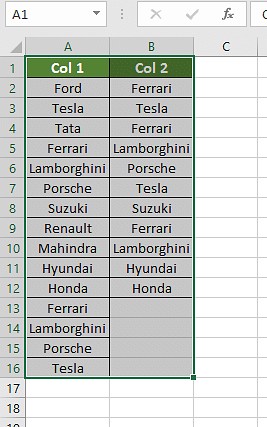Comparing two columns in Excel is a common task in data analysis. It helps identify matches, discrepancies, and unique values for reporting, cleaning, and analysis. Doing this manually can be time-consuming, especially with large datasets. Fortunately, Excel offers several efficient methods to compare columns quickly and accurately. This guide will explore various techniques, including conditional formatting, formulas, and functions, to help you master how to compare two columns in Excel.
Comparing Columns in Excel: Methods and Techniques
Excel provides a range of tools for comparing columns. The best method depends on the specific comparison you need to perform and the desired outcome.
1. Conditional Formatting
Conditional formatting allows you to visually highlight cells based on their values. To compare two columns:
- Select both columns.
- Go to Home > Conditional Formatting > Highlight Cells Rules > Duplicate Values. Choose a formatting style to highlight matching or unique values.
This method quickly identifies similarities and differences without altering the data. You can highlight duplicates, unique values, or values that meet specific criteria.
2. Using the Equals Operator (=)
For a simple row-by-row comparison, use the equals operator in a new column. For example, in cell C1, enter =A1=B1. This formula returns TRUE if the values in A1 and B1 are identical and FALSE otherwise.
You can enhance this by using the IF function: =IF(A1=B1,"Match","No Match") to display custom messages.
3. Leveraging the VLOOKUP Function
VLOOKUP searches for a specific value in the first column of a range and returns a value in the same row from a specified column. This helps determine if a value in one column exists in another.
=VLOOKUP(A1,B:B,1,FALSE) searches for the value of A1 in column B. If found, it returns the value; otherwise, it returns an error (which can be handled using IFERROR).
4. Employing the EXACT Function
EXACT is case-sensitive, comparing two text strings and returning TRUE if they are identical, including case, and FALSE otherwise. This is crucial when case differences matter.
=EXACT(A1,B1) compares the text in A1 and B1, considering case sensitivity.
5. Utilizing the IF Formula with Variations
The IF formula provides greater flexibility. Combine it with other functions for more complex comparisons.
-
=IF(A2=B2,"Same car brands","Different car brands")compares car brands and returns specific messages.
-
=IF(AND(A2=B2,A2=C2),"Complete match","")checks for matches across multiple columns.
Choosing the Right Method
- Conditional Formatting: Ideal for visually identifying similarities and differences quickly.
- Equals Operator (=) and IF Function: Suitable for simple row-by-row comparisons with custom outputs.
- VLOOKUP: Useful for finding if a value in one column exists in another, potentially returning associated data.
- EXACT: Essential for case-sensitive text comparisons.
- IF with AND, OR, COUNTIF: Enables complex comparisons involving multiple criteria and columns.
Conclusion
Mastering How To Compare 2 Columns in Excel empowers you to efficiently analyze data, identify discrepancies, and gain valuable insights. By understanding and utilizing these various methods, you can streamline your workflow and make informed decisions based on accurate data comparisons. Experiment with these techniques to discover the most effective solutions for your specific needs.
